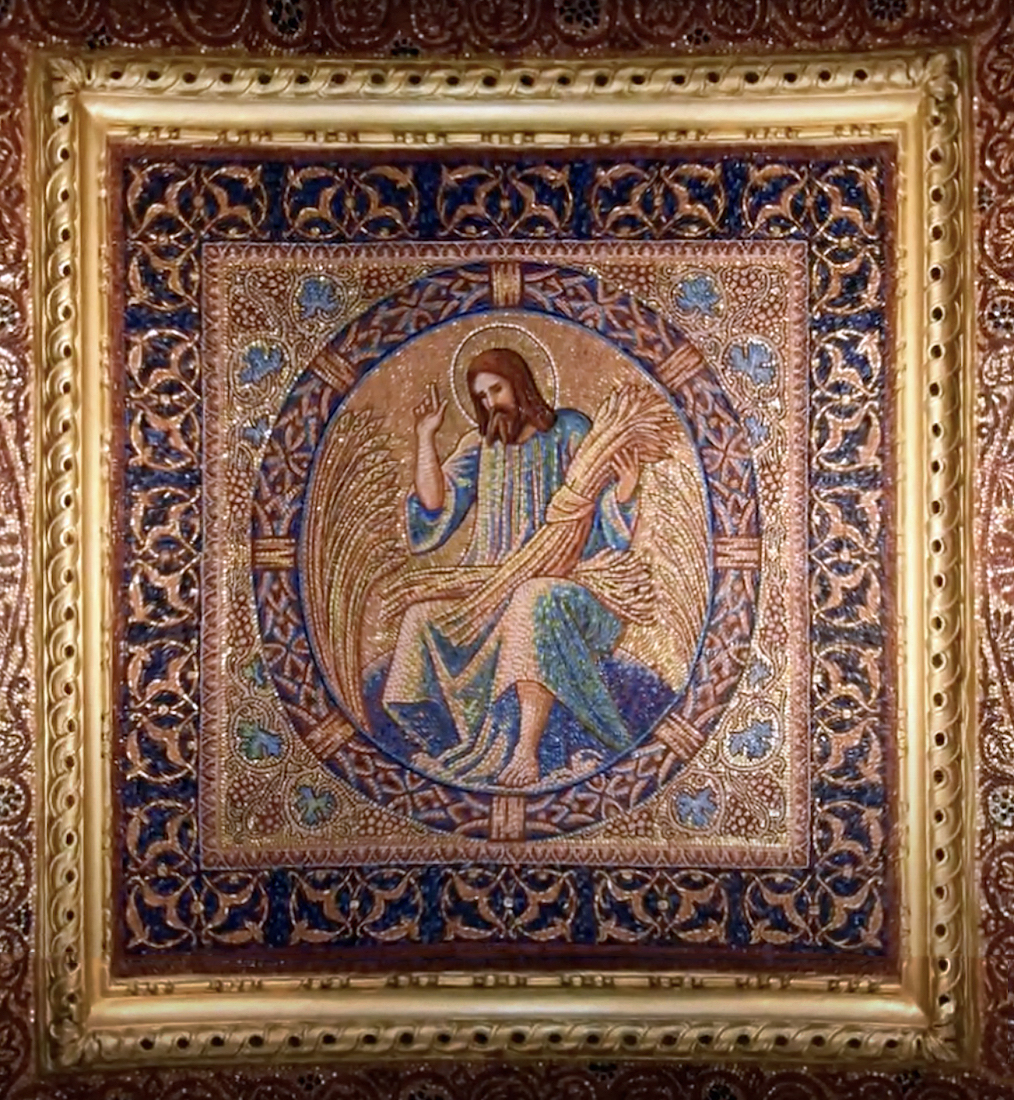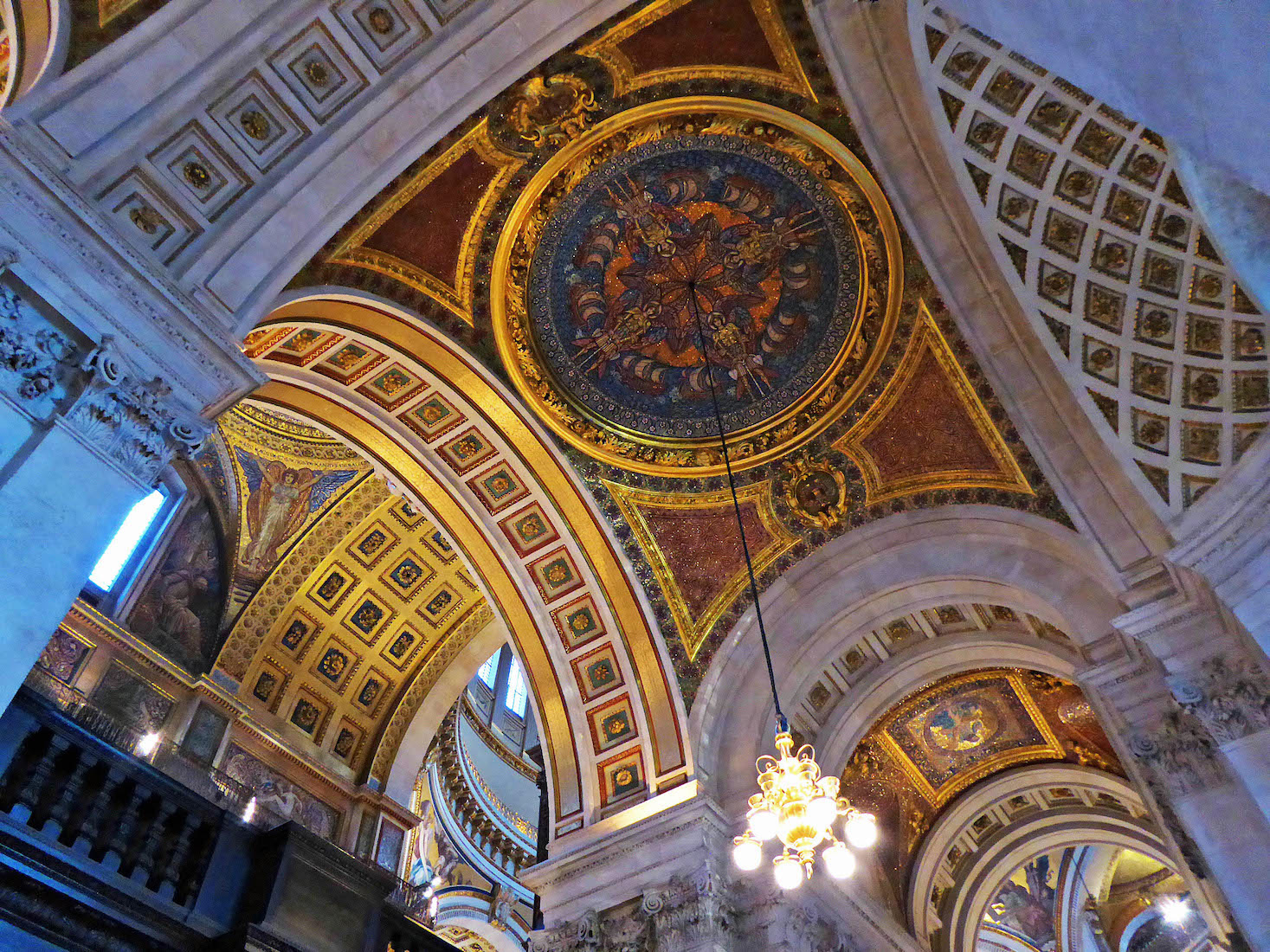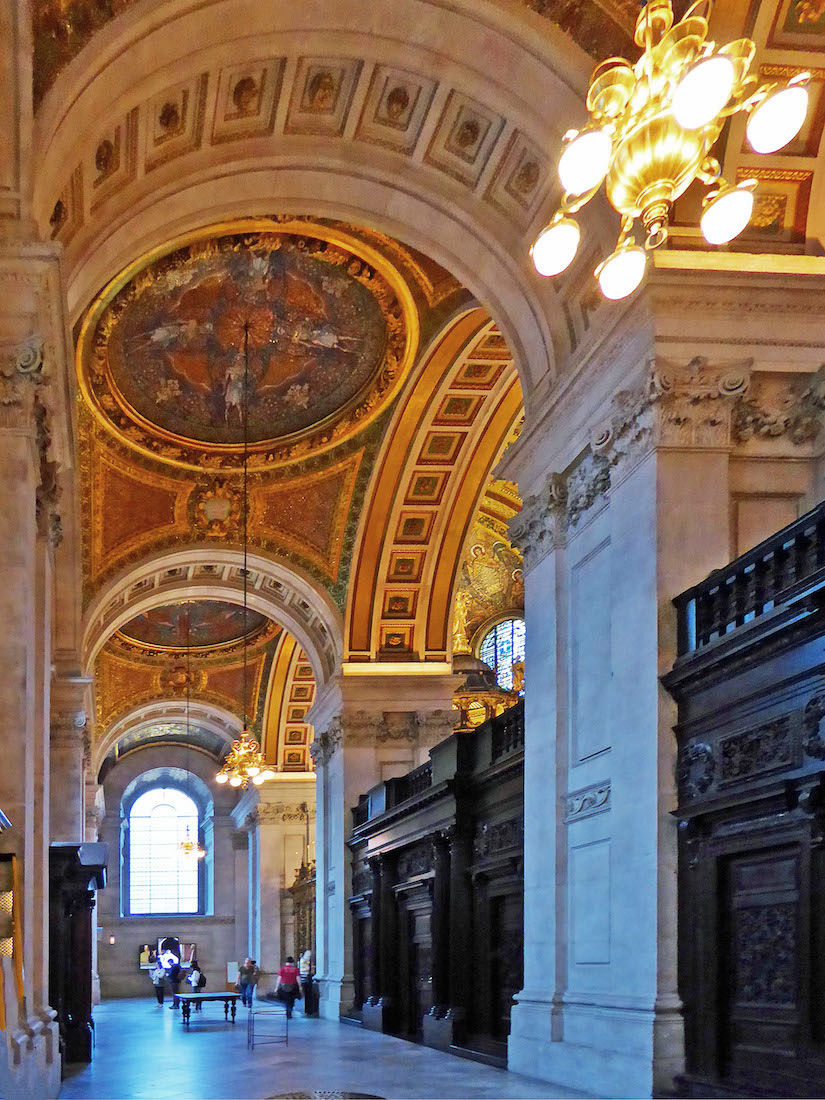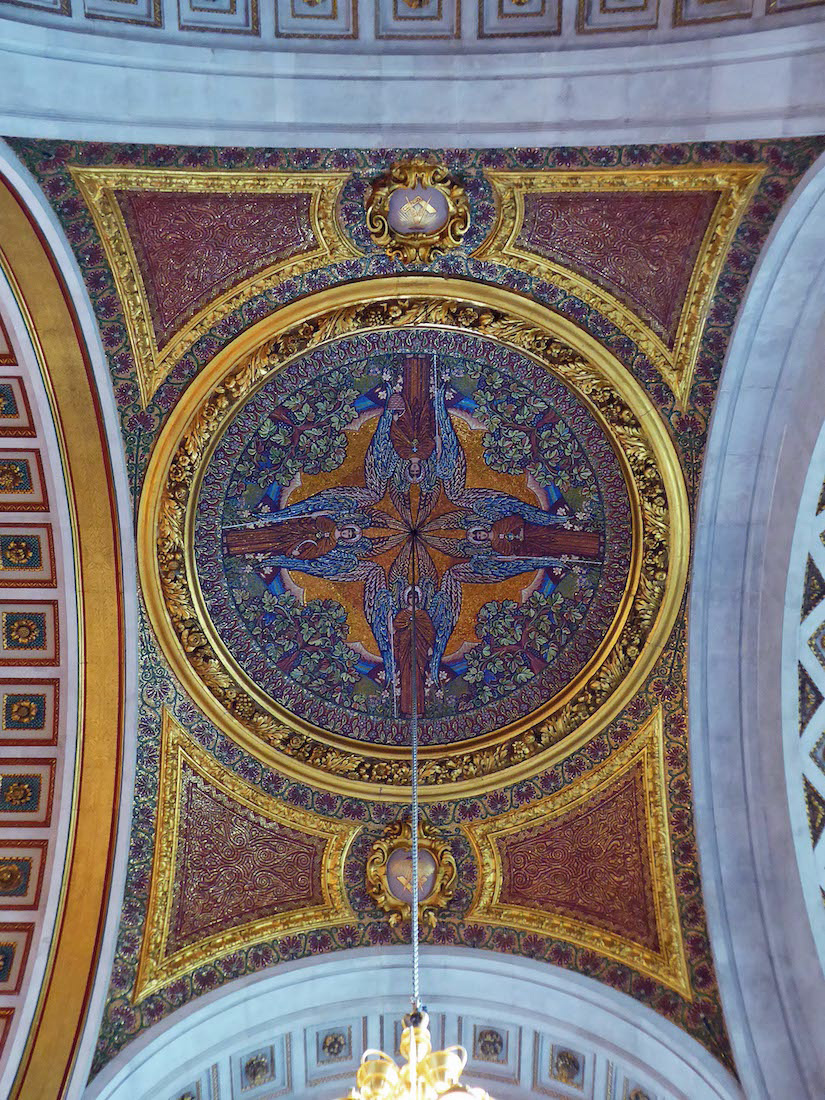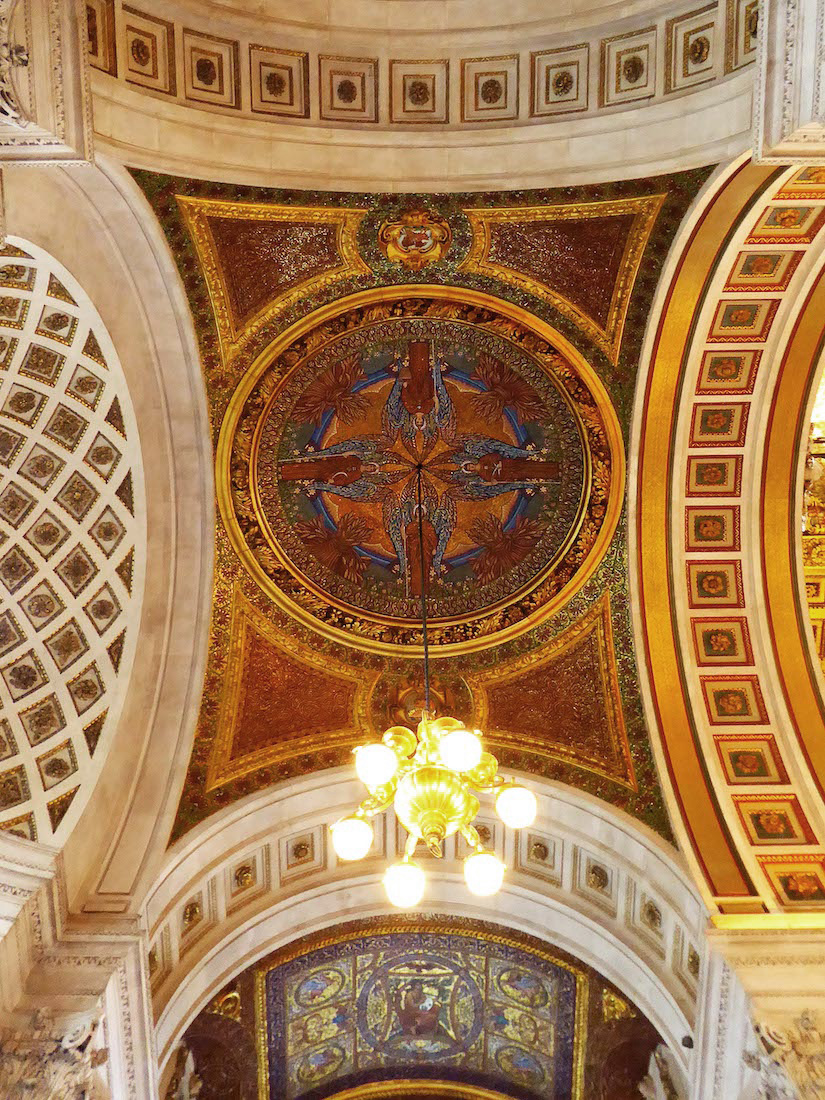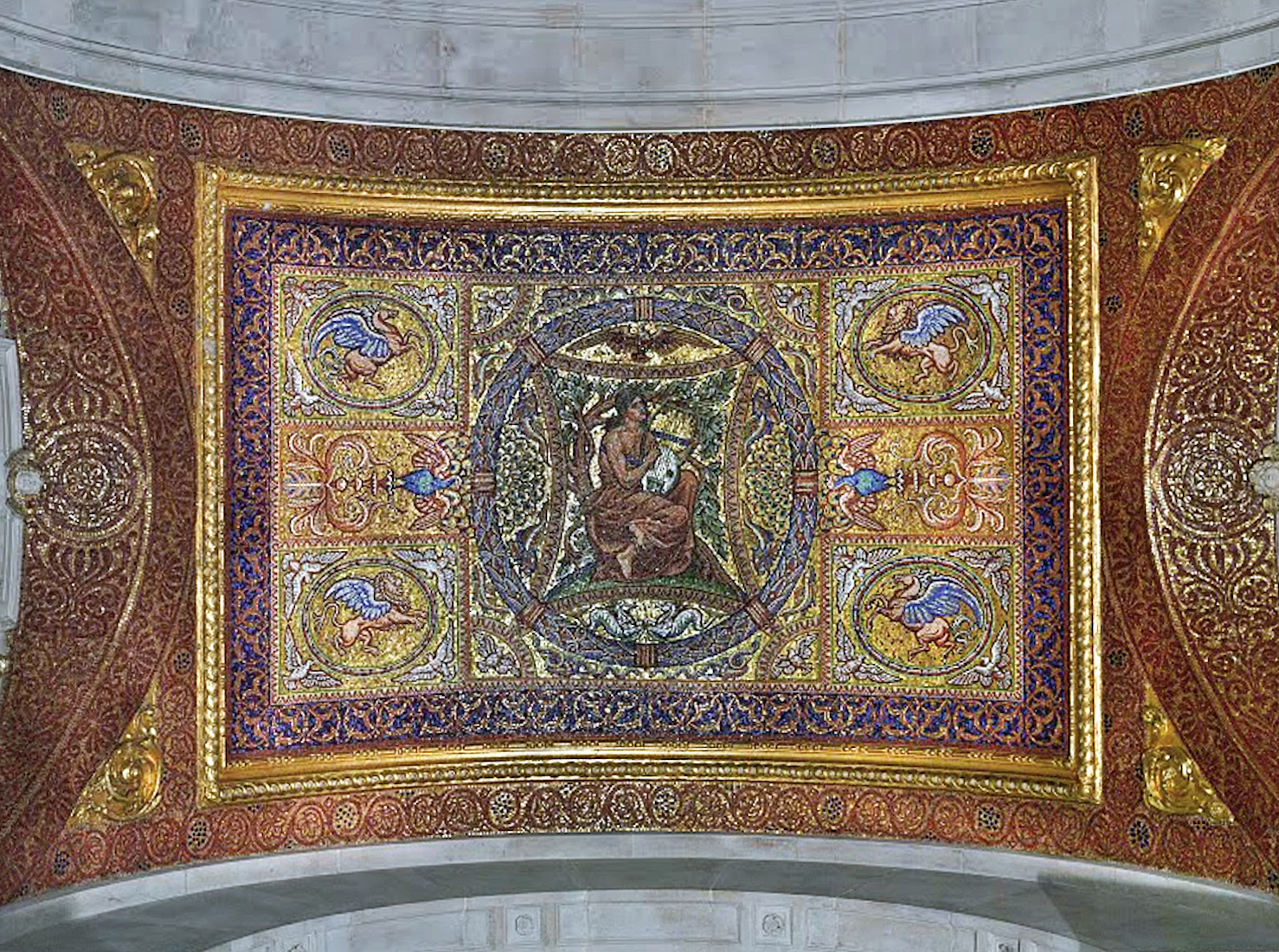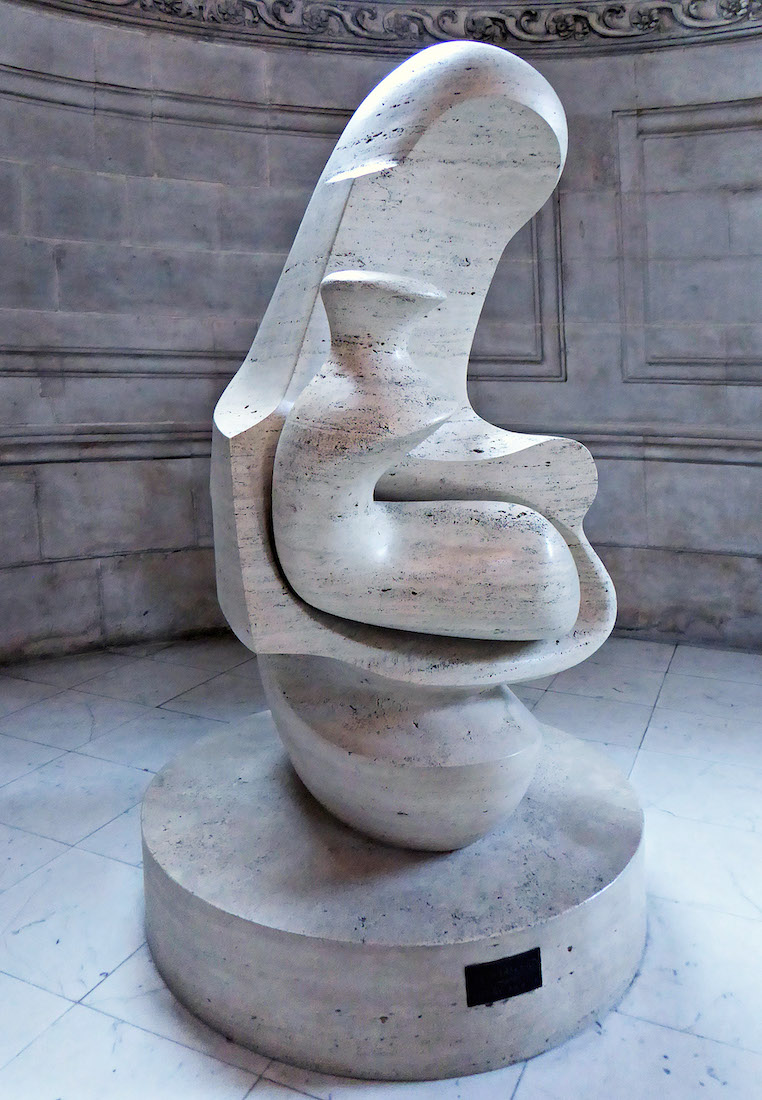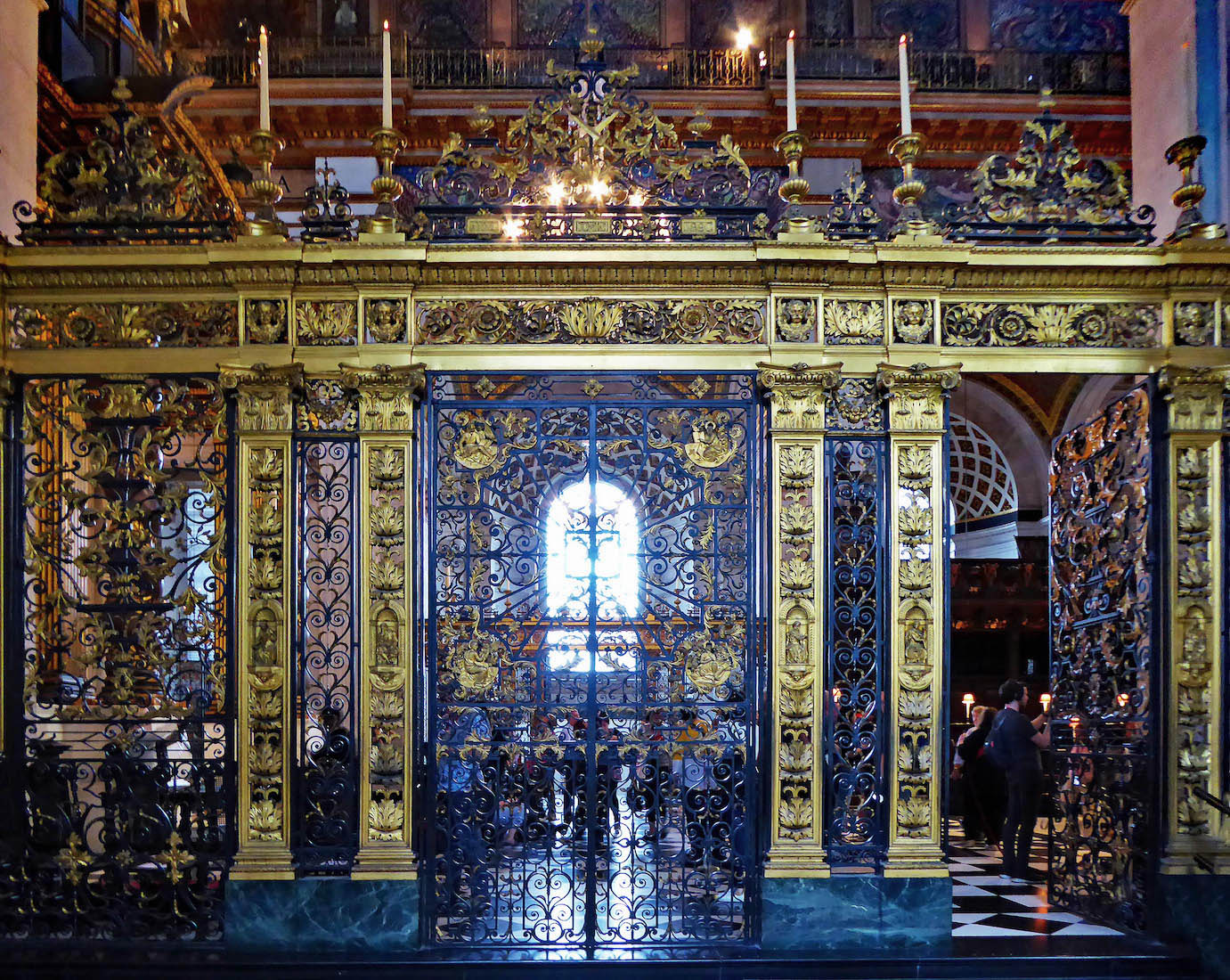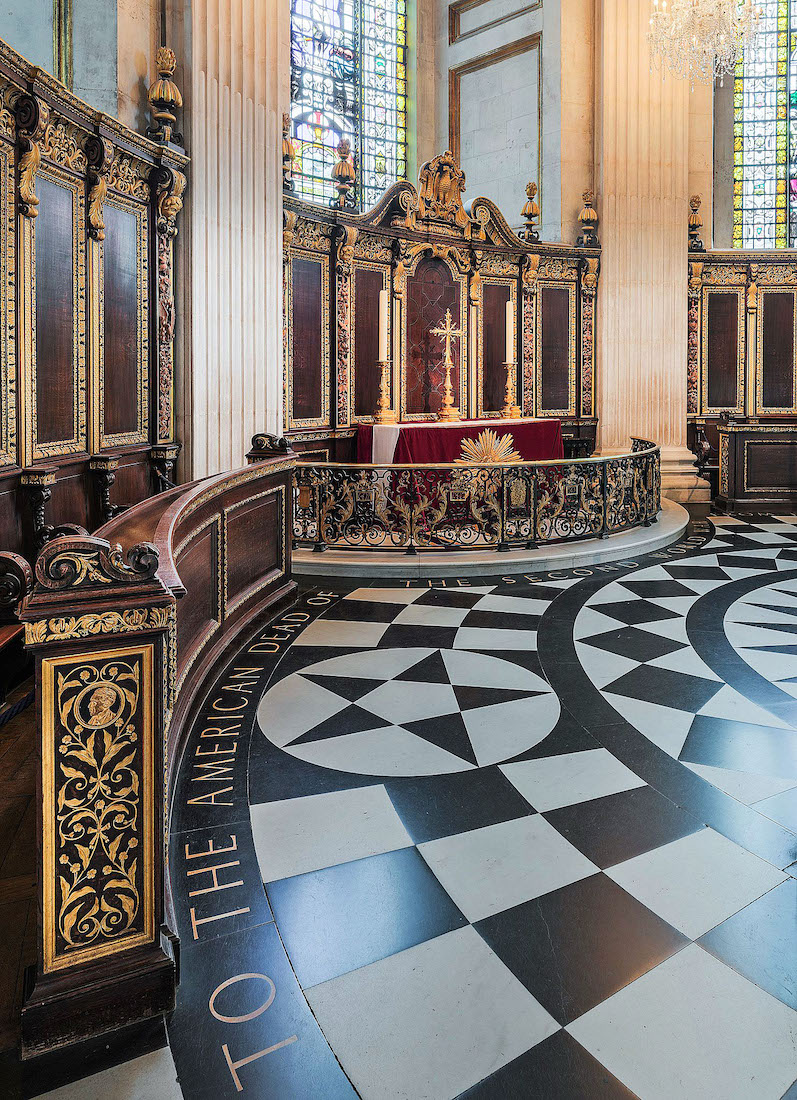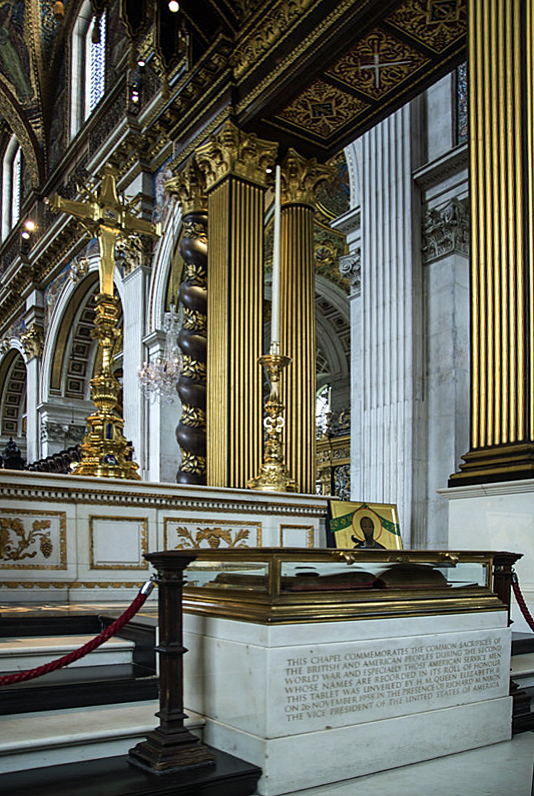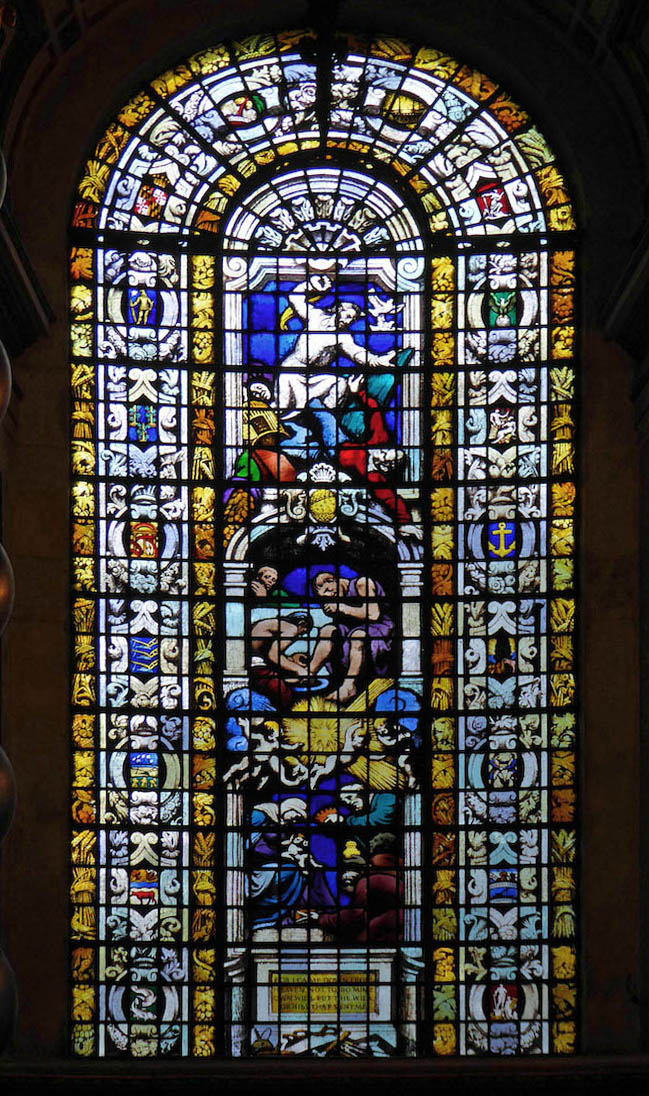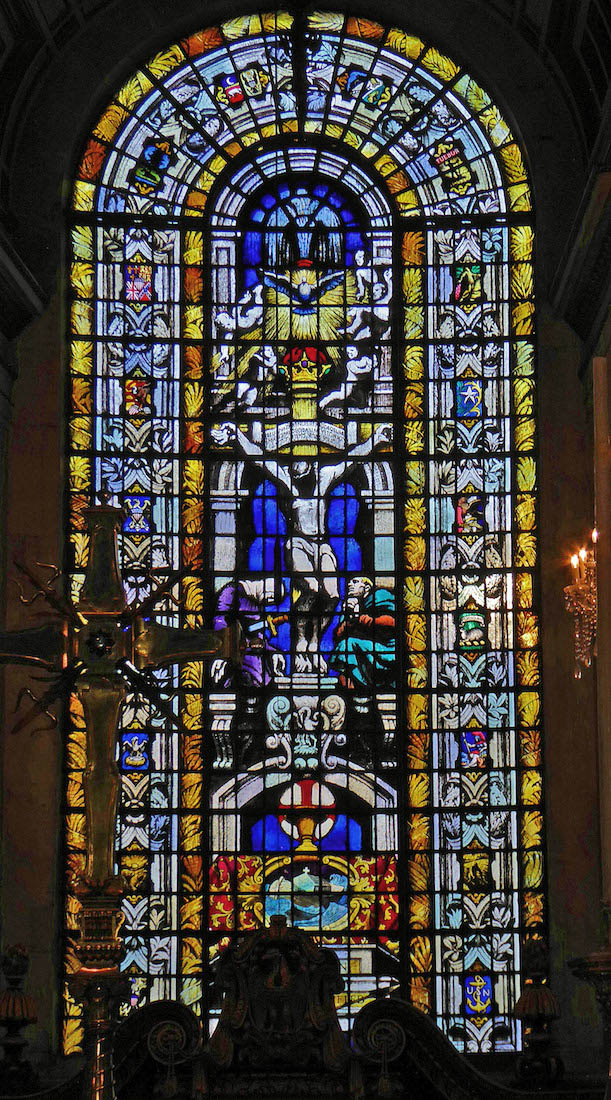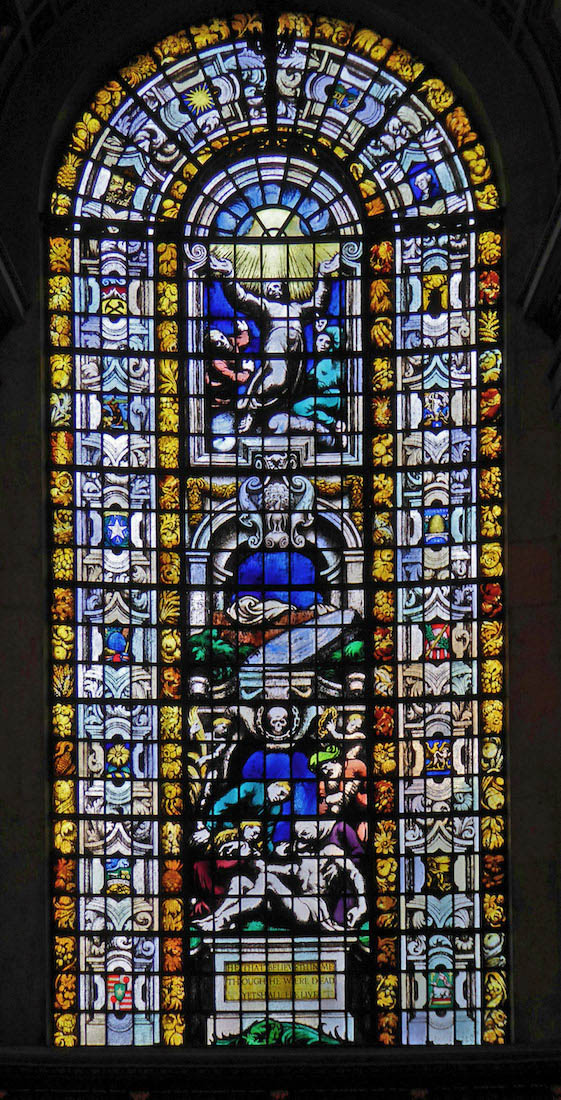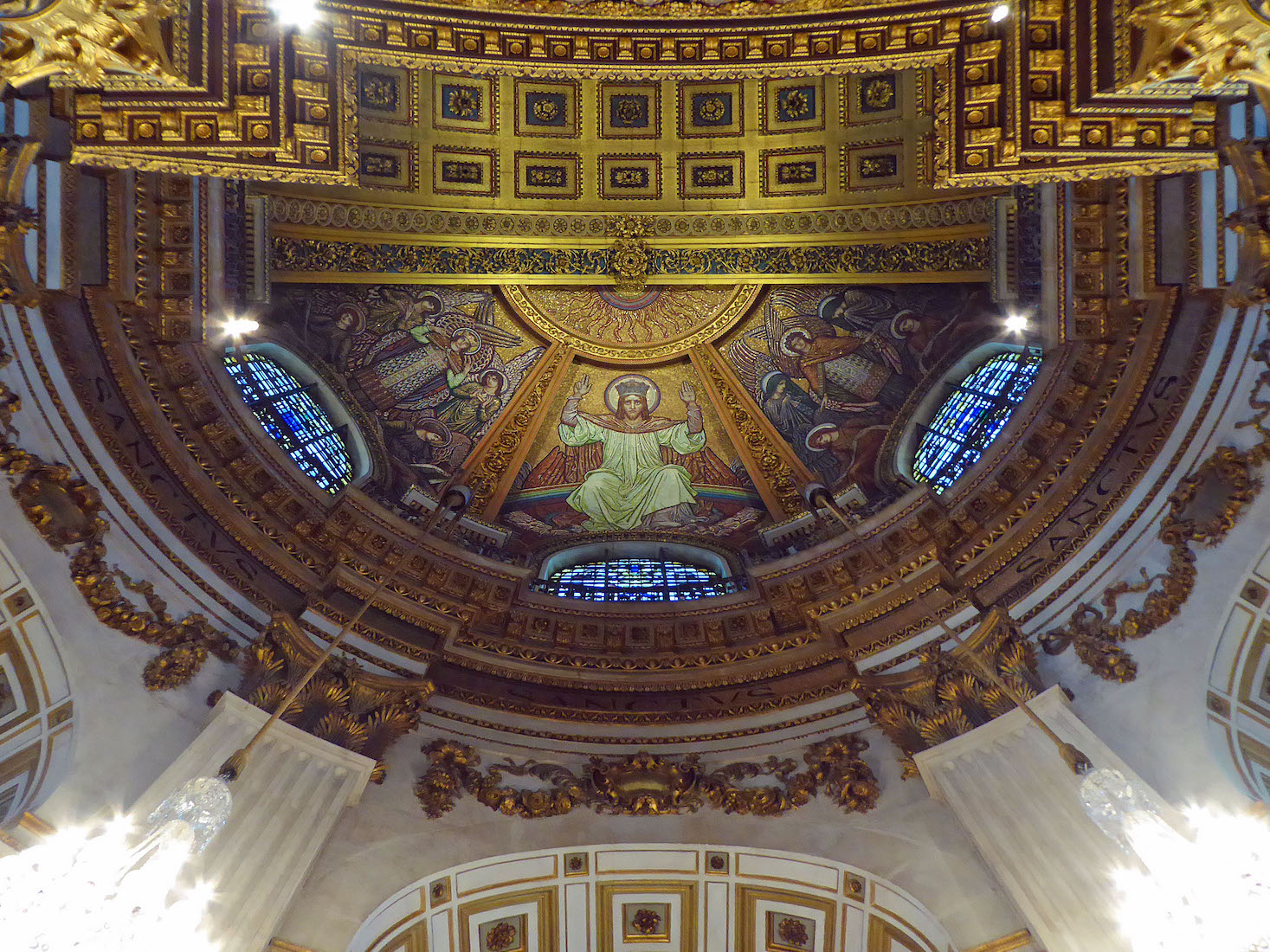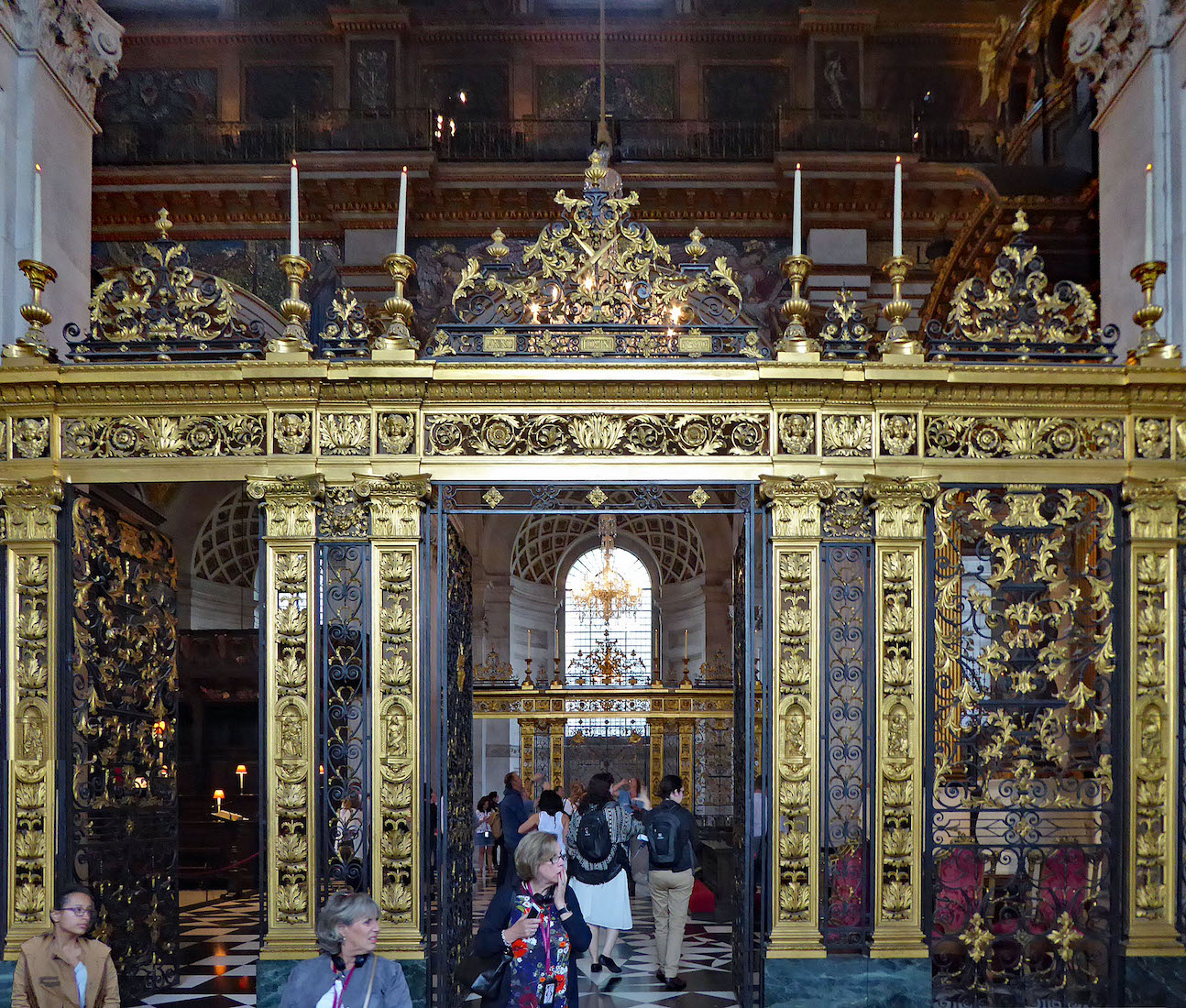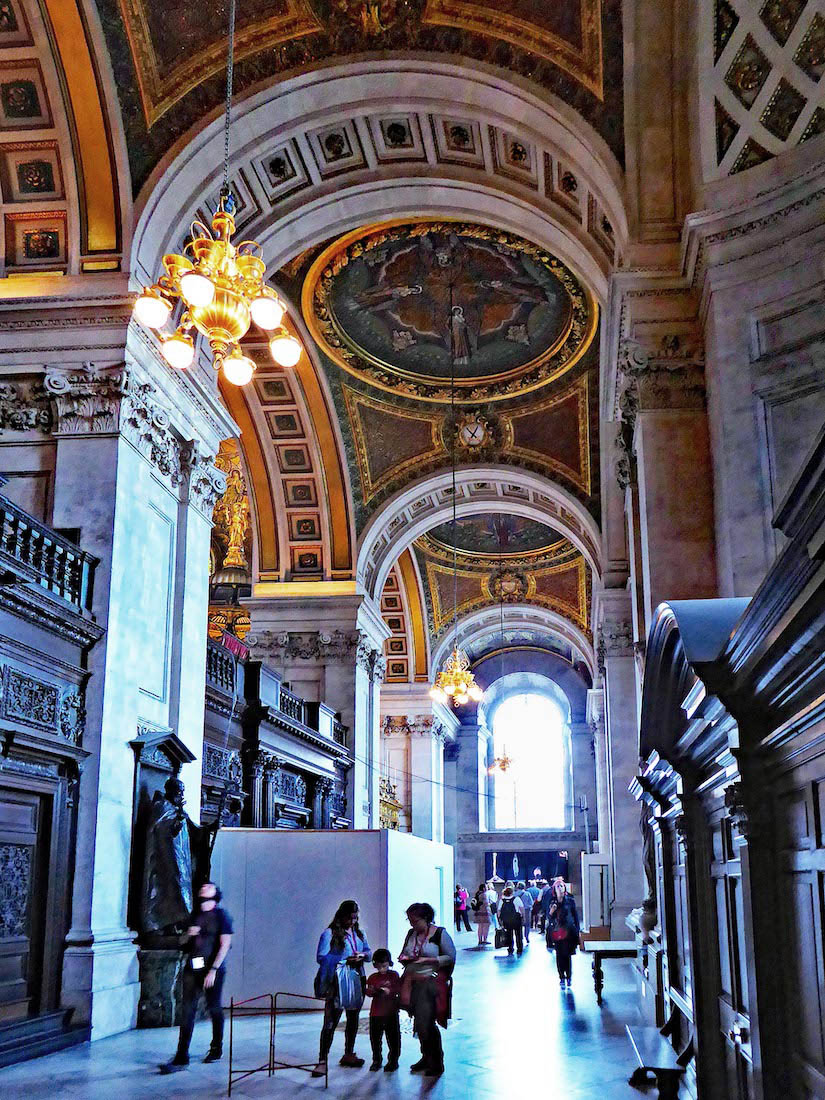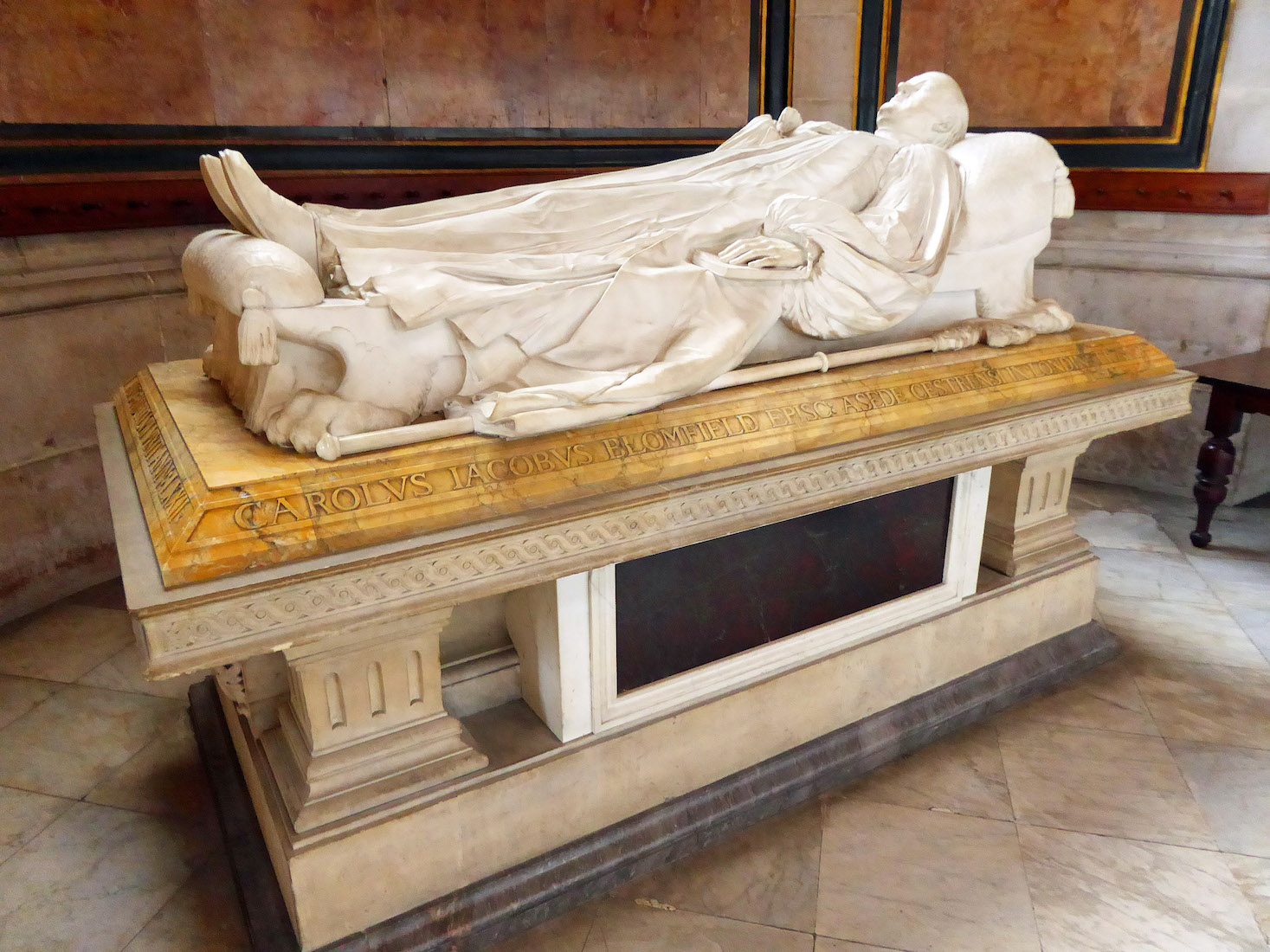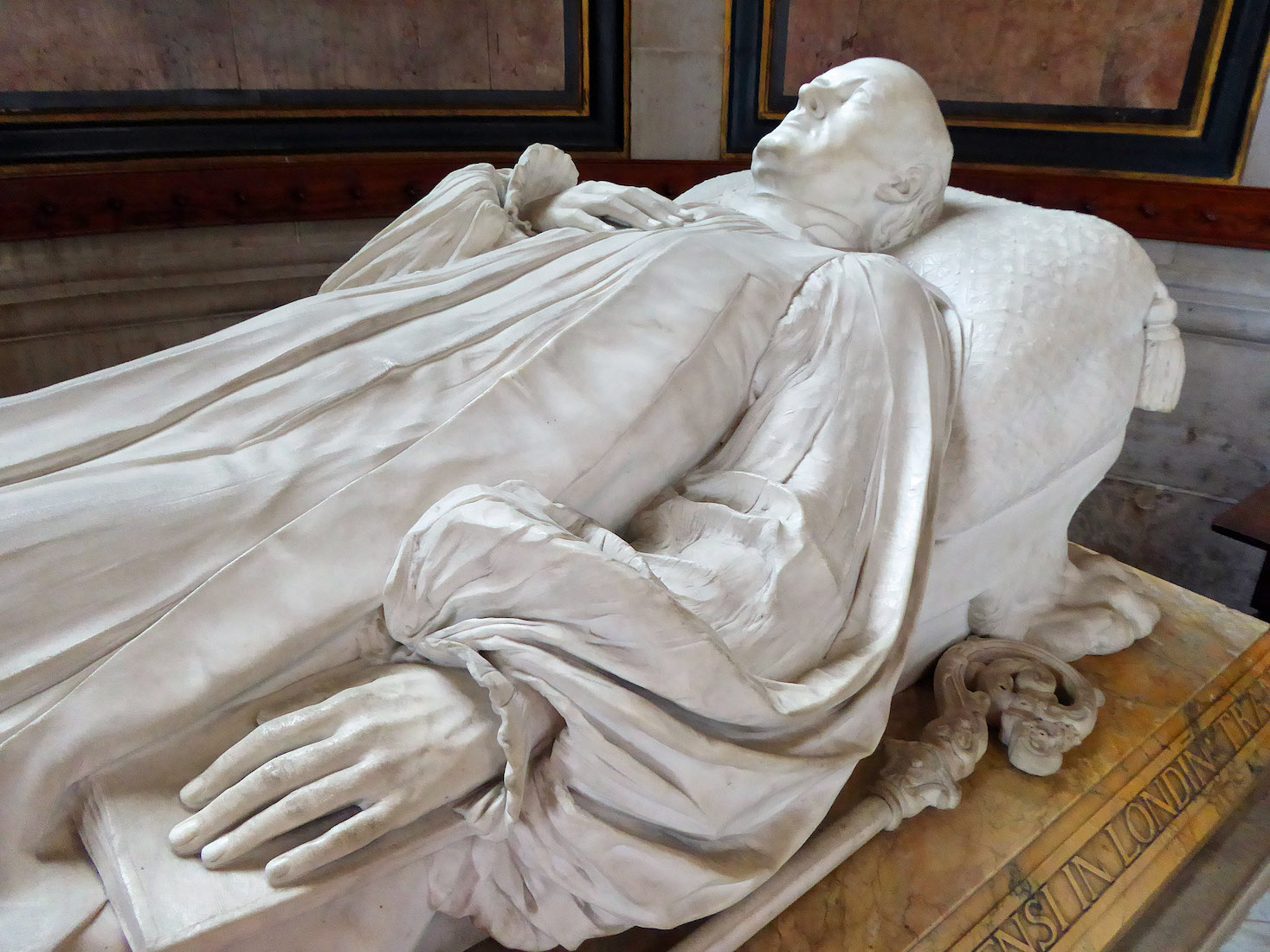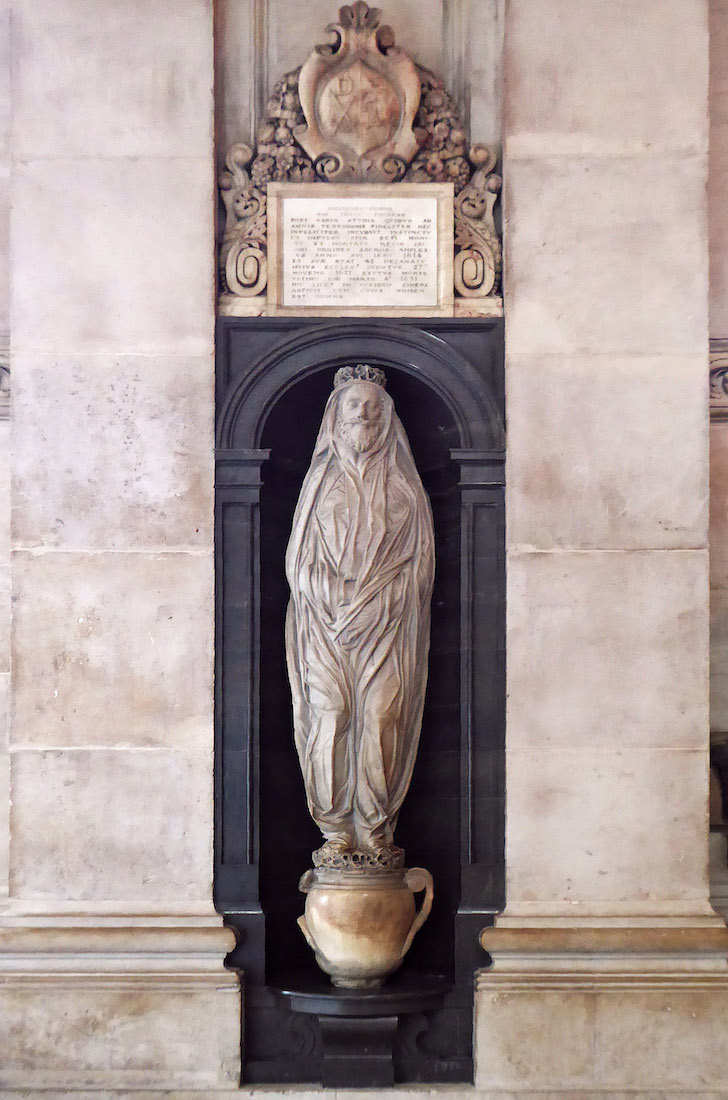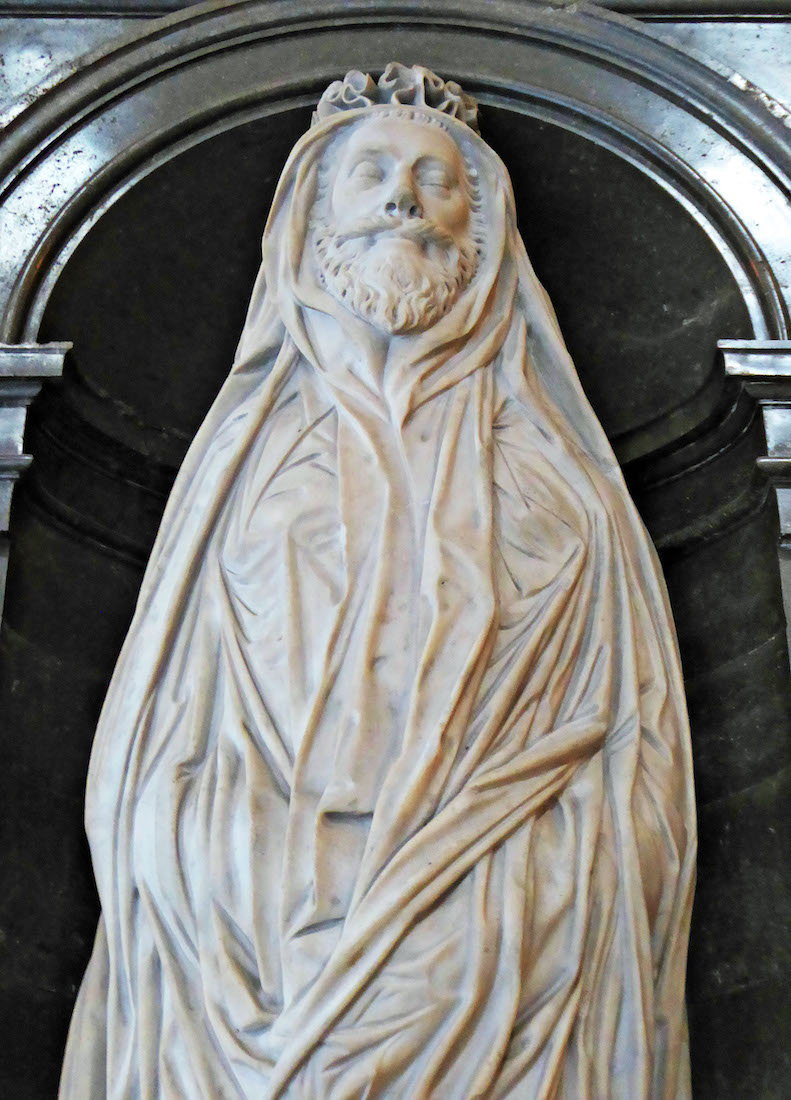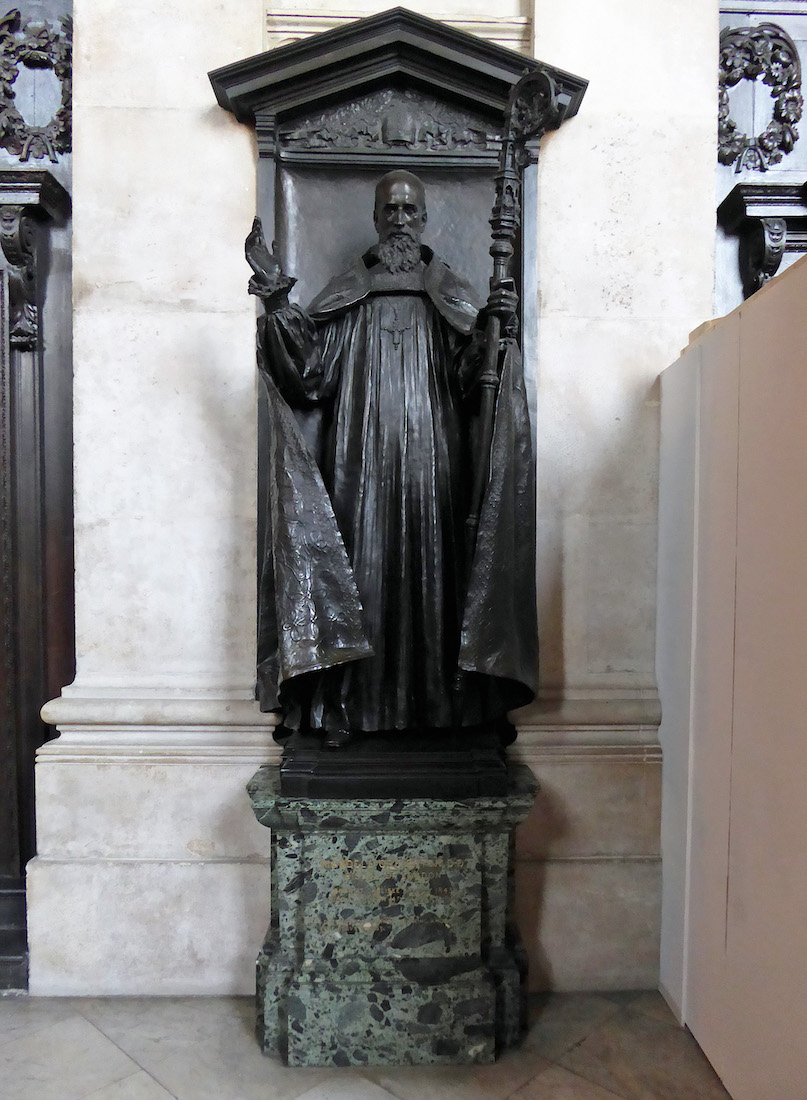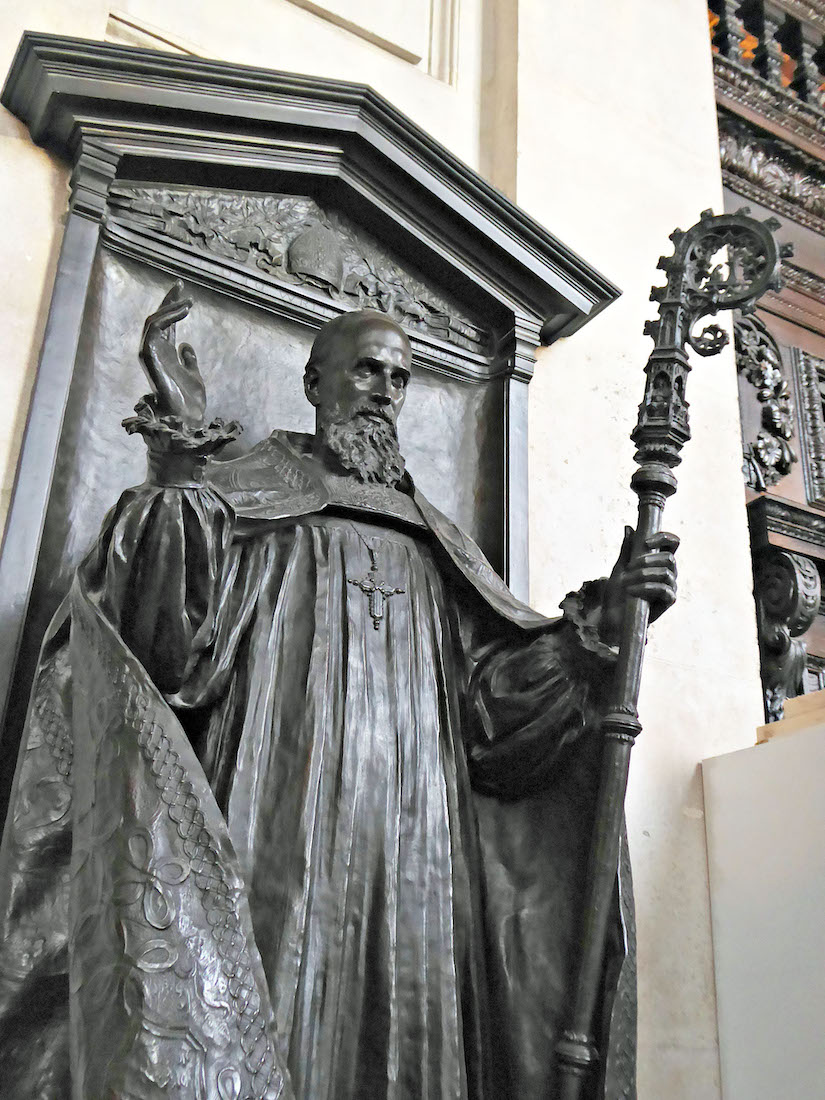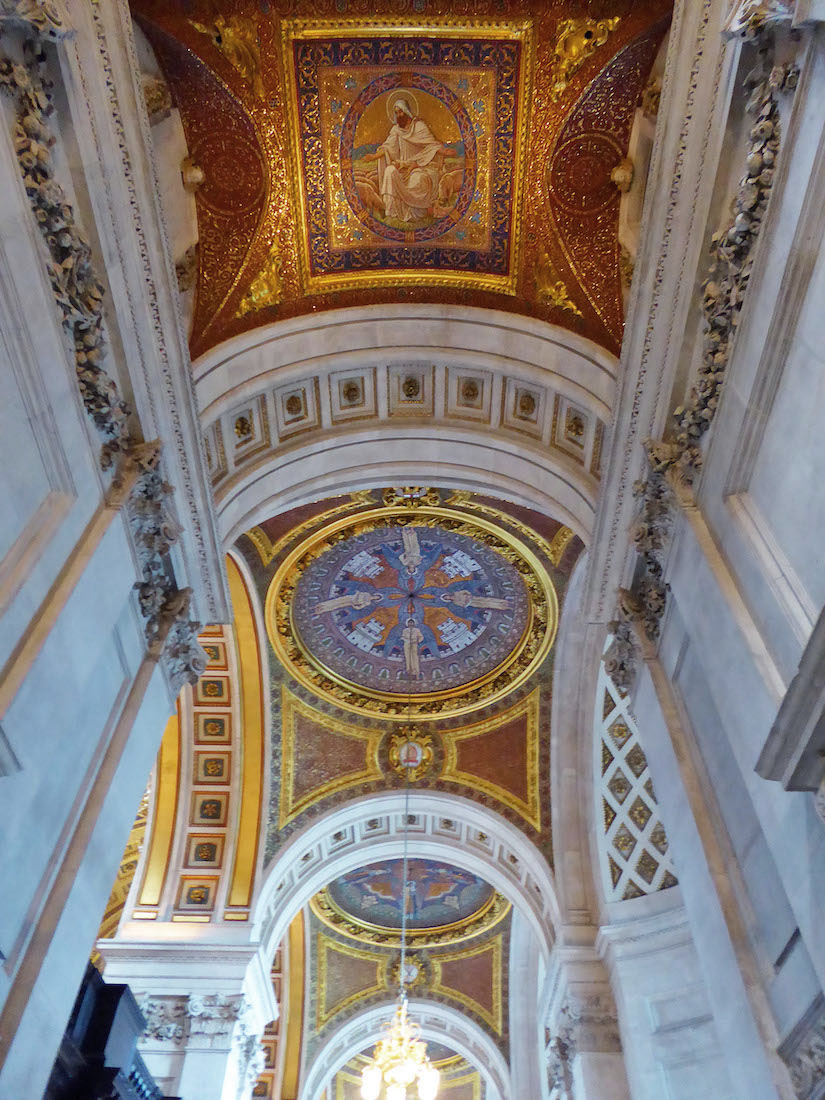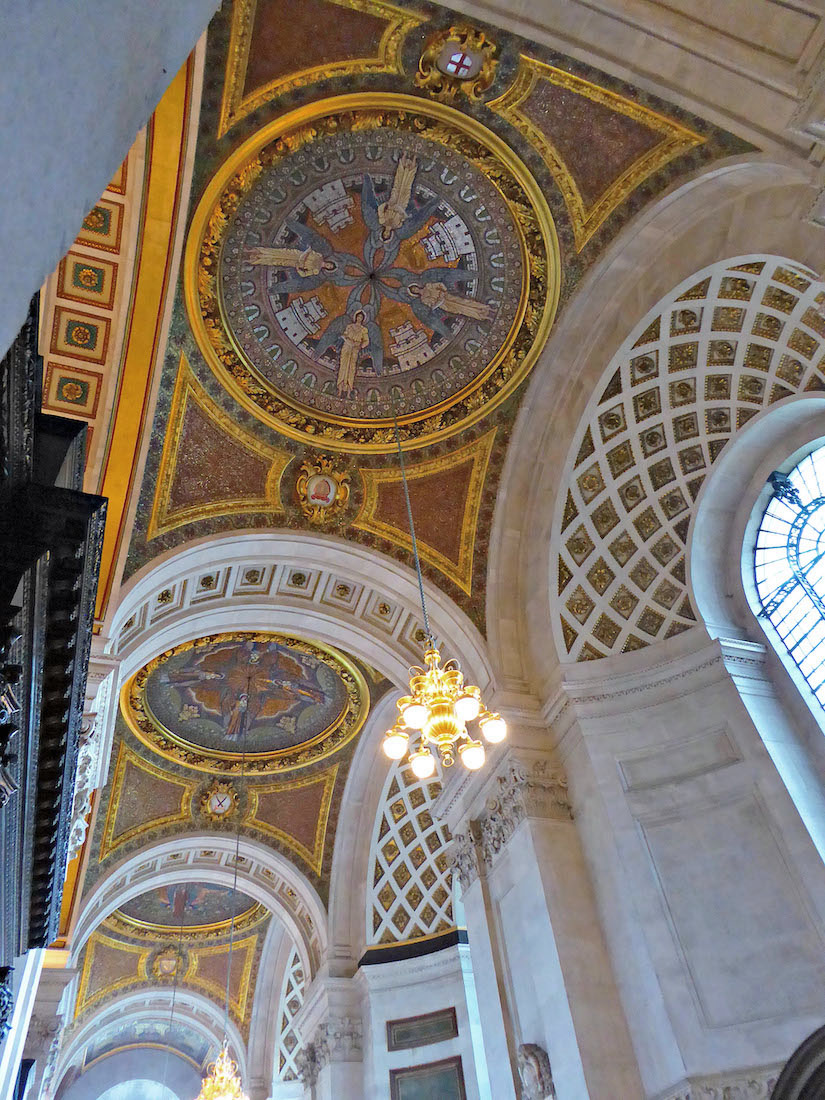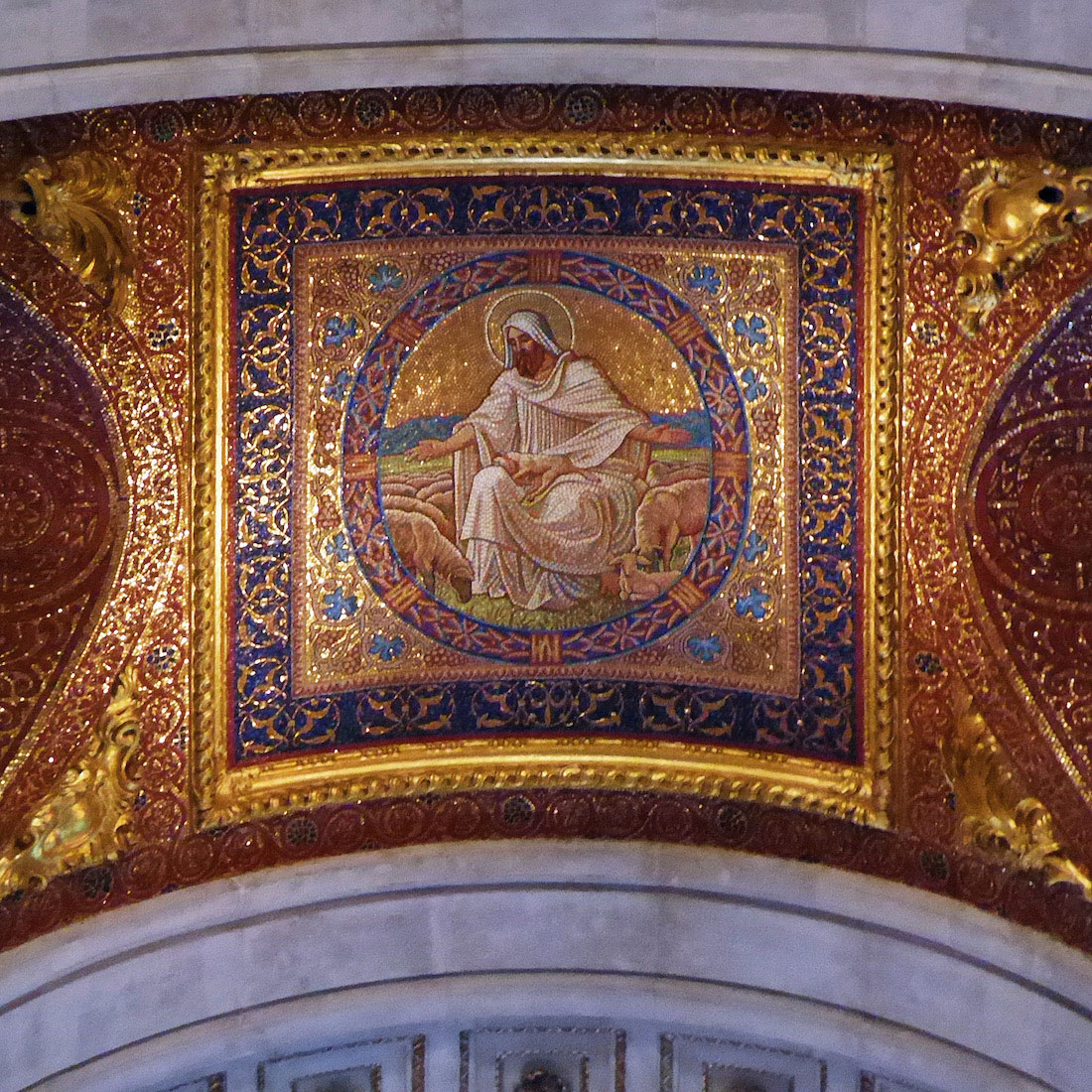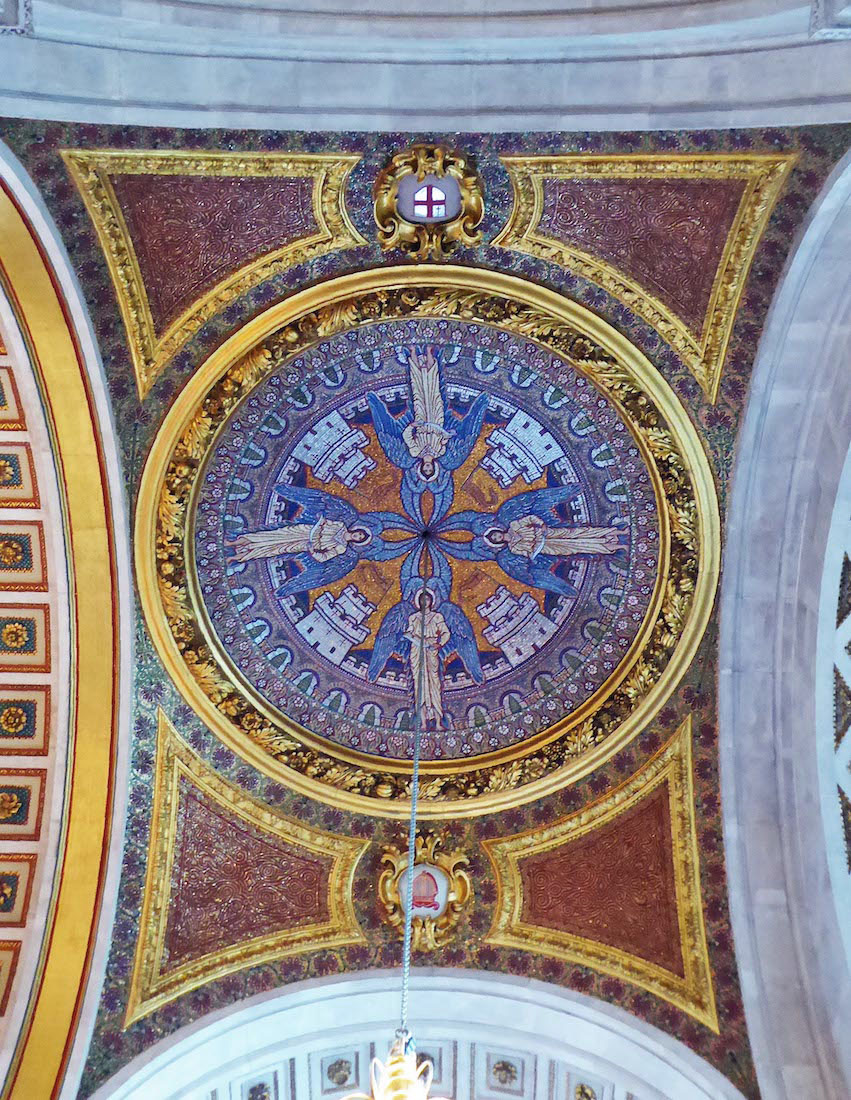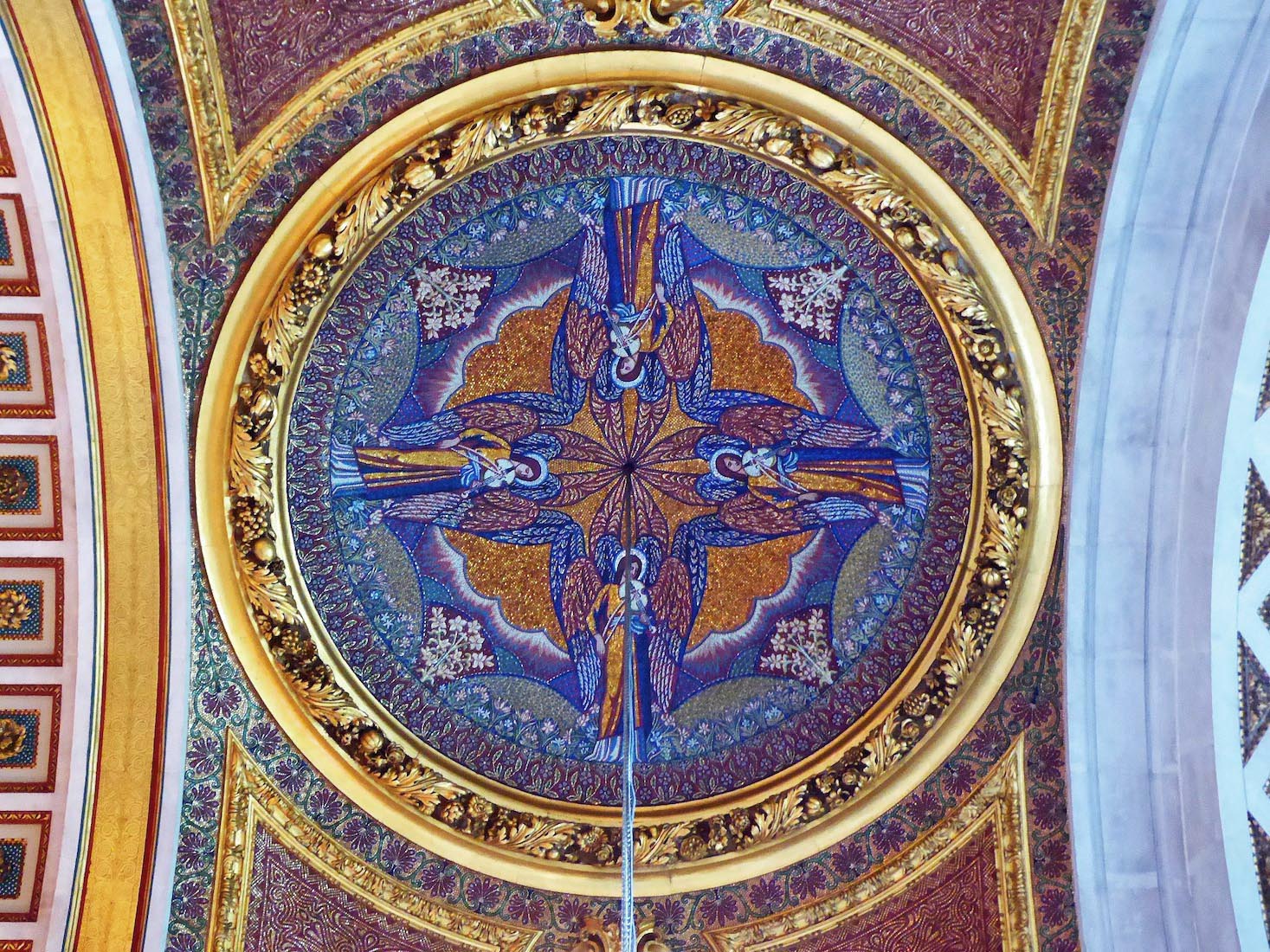QUIRE AND SANCTUARY
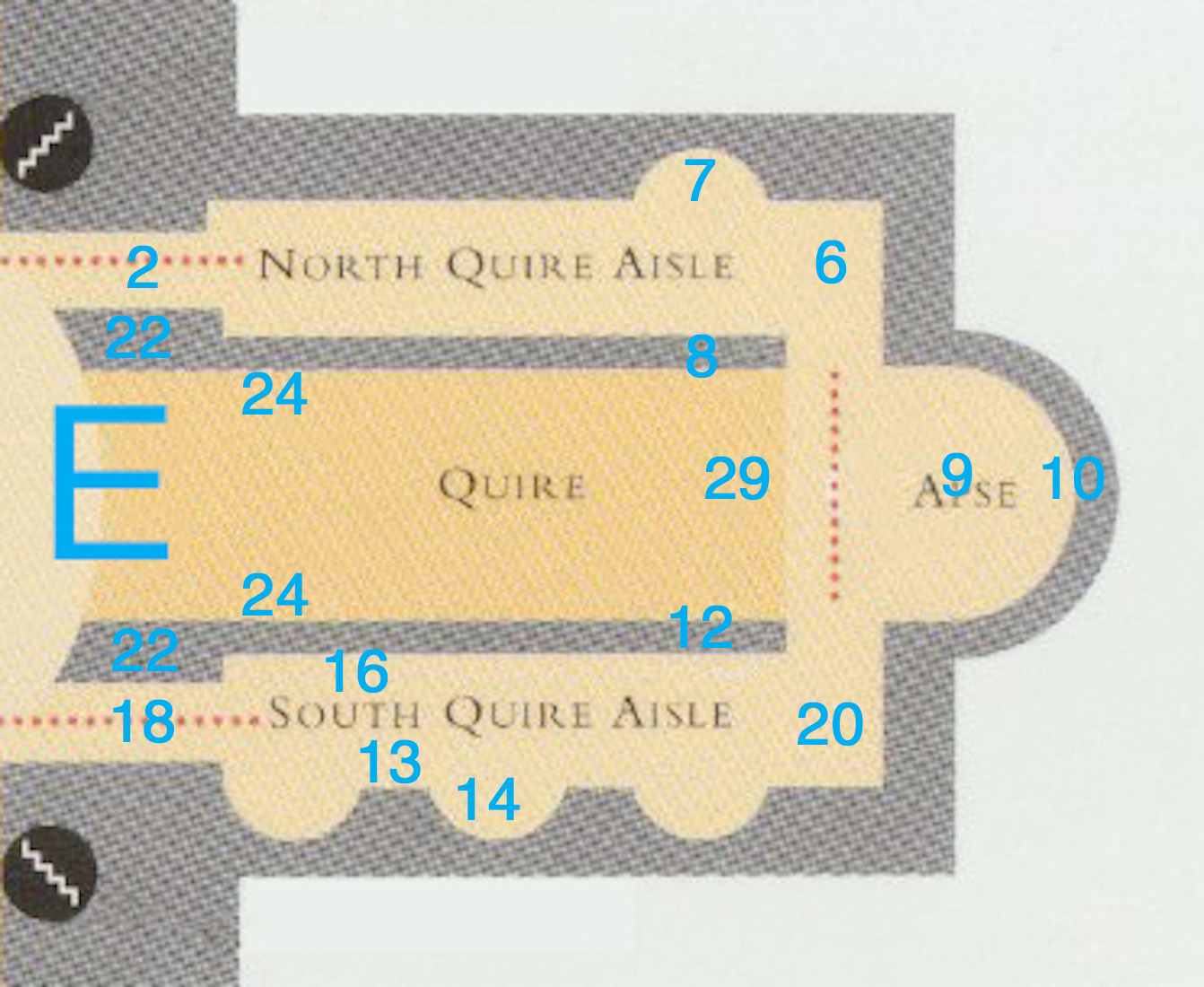
This is the most ornately decorated part of St Paul’s Cathedral. There is a central space which contains the quire stalls and organ leading through to the apse with the high altar and the Jesus Chapel (American Memorial Chapel) behind. An aisle to the North and an aisle to the South link behind the high altar, forming a single ambulatory. We shall begin our exploration by entering the North quire aisle (top left) and following right around, before returning to walk up the central space to the high altar. There is much to see and admire here: most of it up high! INDEX
E1. EAST VIEW AMT
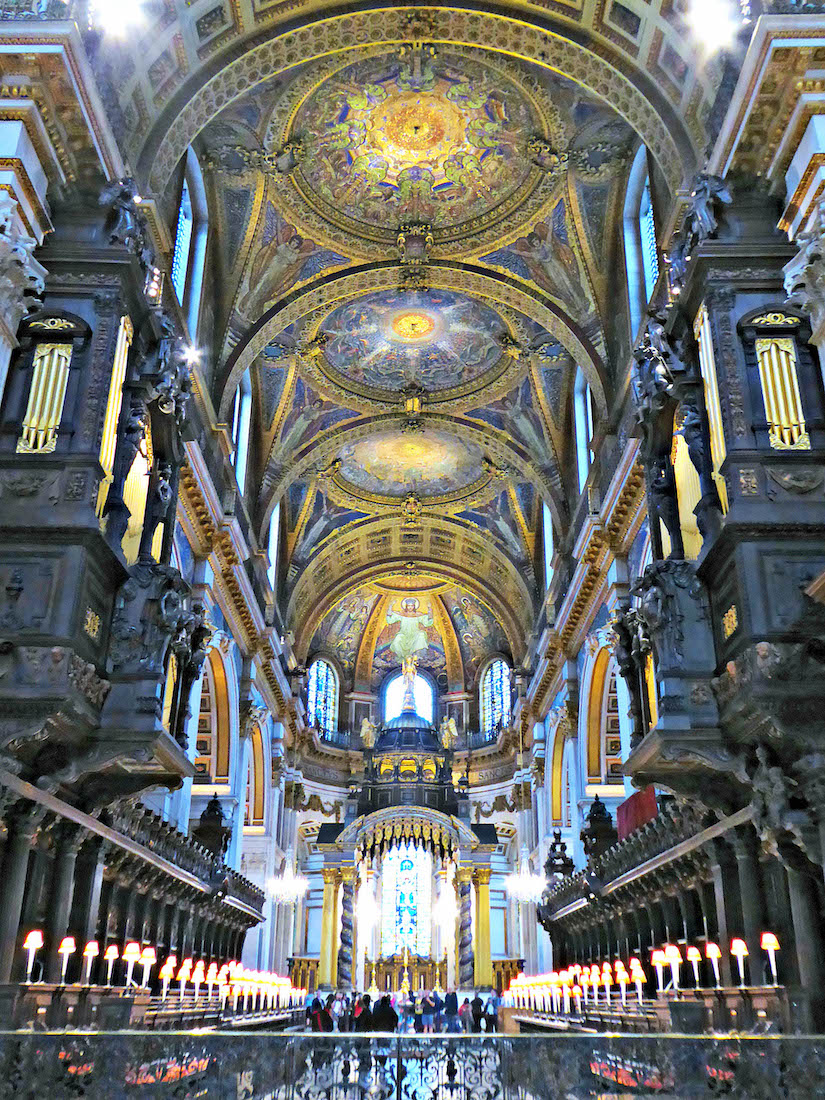
Returning to the crossing we look East towards the high altar. What an amazing array of light and colour! As we saw from the plan, there is an aisle on either side of this central space – in fact an ambulatory which goes right round. We shall first follow this, starting from the North side.
E2. NORTH CHOIR AISLE AND MOSAIC PANEL AMT SPC
From the crossing under the dome, we enter the North quire aisle through an impressive steel gateway. High above us is an intricately carved frieze and a bright mosaic panel showing Christ in a field of wheat sheaves. One can picture Jesus telling one of his parables – perhaps the parable of the Wheat and the Tares (Matthew 13:24–30). This panel is the work of Sir William Blake Richmond. Richmond designed bold, colourful mosaics for the Cathedral quire and apse; over seventy allegorical mosaic panels were installed, along with spandrels and ornamental mosaic ceiling decoration. [Second Photo Credit: St Paul’s Cathedral]
E3. NORTH QUIRE VAULTING AMT
Walking through this part of St Paul’s Cathedral, the photographer feels inclined to point the camera in a random direction and see what eventuates! Such a vast array of brilliant decoration ... . Here we concentrate on the Westernmost dome in the North quire aisle. It has the title ‘Angels with Boats’, and we can see the four angels, and a ring of sailing ships.
E4. NORTH CHOIR AISLE AMT
The North quire aisle is remarkably sparse. There are the wonderful mosaics overhead – two further domes and another panel – but seen here, a large cupboard to the left, and to the right, the overpoweringly large dark backs of the quire stalls. At the far end there are some golden gates (far right), a modern televised video presentation, and out of sight to the left, a sculpture.
E5. NORTH QUIRE DOMES AMT
The central dome in the North aisle depicts Angels with Staves in a garden setting; the next dome to the East shows Angels with Wheat Sheaves, picking up the theme of the first panel. Small motifs between include the Masonic square and compasses.
E6. ORPHEUS PANEL SPC
The East end mosaic panel by William Blake Richmond depicts Orpheus playing his lute. In the surrounds there is the winged horse Pegasus (twice), two winged lions, and various doves. It is unclear why this panel appears here! [Photo Credit: St Paul’s Cathedral]
E7. MOTHER AND CHILD AMT
In the Easternmost Northern recess we find Henry Moore’s Mother and Child: Hood. Moore’s semi-abstract sculptures helped create a very specific form of modernism in the United Kingdom. This work was completed in 1983 out of travertine marble, and seeks to convey the grieving Mary after the crucifixion of Jesus Christ using minimal detail. The sculpture is on loan to the Cathedral. It is quite evocative and appropriate, but I wonder if it fits with its setting?
E8. TIJOU NORTH GATES AMT
Jean Tijou, who was active from around 1689 to 1712, was an ironworker born in France, but known only for his work in England, notably his contribution to St Paul’s. W. M. Sinclair writes of Tijou: "Tijou was a French artist in metal of whom Wren had heard and to engage whom, he went over to Paris himself. The ironwork gates and grilles in the Quire, the railing of the Geometrical Staircase of the West Gallery, and of the four Galleries in the Dome, are the monuments of his exquisite genius."
E9. JESUS CHAPEL AND BOOK OF REMEMBRANCE W
We walk through the North Tijou gates, and enter this chapel behind the high altar. It is known as the Jesus Chapel, or the American Memorial Chapel. The chapel has its own altar below the apse windows, and a Book of Remembrance directly behind the high altar. St Paul’s has had a long relationship with the American people, formed largely after the Second World War, a conflict in which thousands of Americans based within the UK were to give their lives. The most visible striking reminder of this sacrifice and subsequent deep friendship can be found here – a space rebuilt after being destroyed in the Blitz and dedicated in its entirety to the American dead of WW2. At the heart of the chapel sits a huge, 500-page, leather-bound book; a roll of honour to the 28,000 Americans – from Aaberg to Zingale – stationed in the UK who gave their lives throughout the War. The book opens: "Defending freedom from the fierce assault of tyranny they shared the honor and the sacrifice. Though they died before the dawn of victory their names and deeds will long be remembered where ever free men live.” Click here for a closer view of the Book of Remembrance. [Photo Credits: David Iliffe, Wikimedia; Iain McLaughlin]
E10. APSE WINDOWS AMT AMT AMT
Behind the Jesus Chapel are six stained glass windows designed by Brian Thomas and installed during the post-war restoration in the 1950s. Thomas’s style is appropriately neo-Baroque and harmonises well with its surroundings. These six windows contain the only stained glass in the Cathedral. (The three smaller upper windows are harder to access or photograph so are not shown here). Many Victorian windows throughout the building were destroyed during the War, but their subsequent replacement with plain glass has left the Cathedral closer to Wren’s intentions. The three lower windows of the apse depict themes of service and sacrifice, while the insignia around the edges represent the American states and the US armed forces.
E11. APSE VAULTING AMT
We shall take a closer look at the apse vaulting later, by looking straight up here, we notice the three upper apse windows, and the mosaic work depicting the glorified Christ with angels on either side.
E12. TIJOU SOUTH GATES AMT
Leaving the apse we exit through the Southern Tijou gates. These are amazingly detailed, and presumably lit by electric candles? If we could see straight through both the Tijou gates, from here we would have a view of the Mother and Child sculpture.
E13. SOUTH QUIRE AISLE AMT
We are now in the South quire aisle. Some building work is being carried out during our visit, but this is a minor inconvenience. The South aisle is very much like the North aisle, but there is more to see here. The vaulting, quire stall backs and facing cupboard appear here as expected, along with another televised presentation and the South Tijou gates which we have already passed through.
E14. BISHOP BLOMFIELD EFFIGY AMT AMT
However, the curved niche opposite the Tijou gates on this side contains the reclining effigy of Bishop Blomfield. Charles James Blomfield (1786 –1857) was a British divine and classicist, and a Church of England bishop for 32 years. He was appointed a Privy Counsellor and Bishop of London in 1828. He held this post for twenty-eight years making him the third longest-serving post reformation incumbent.
E15. JOHN DONNE AMT AMT
Next to the Blomfield effigy is this memorial to English poet John Donne. John Donne (c.1572 -1631) is buried in St Paul’s Cathedral. A statue was built in his memory by Nicholas Stone based upon a drawing commissioned by Donne himself as he lay dying. It was one of the few to survive the Great Fire of London in 1666. However, faint traces of scorching can be seen on the urn beneath.
E16. BISHOP CREIGHTON AMT
Across the aisle from John Donne stands the black and rather threatening figure of Mandell Creighton (1843 – 1901). Creighton was a British historian and a bishop of the Church of England. He became Bishop of London and it was widely thought at the time that he would become the Archbishop of Canterbury, but his early death, at age 57, supervened.
E17. SOUTH CHOIR AISLE VAULTING AMT
There is wonderful mosaic vaulting in the South aisle. To investigate this we walk down to the crossing end. Above us is a mosaic panel showing Jesus as the Good Shepherd. There are then three domes, and a further panel at the East end. The various arches are decorated with a latticework of golden florets in square frames, and each supporting pillar has a frieze of exaggerated foliage.
E18. GOOD SHEPHERD PANEL AMT
In John 10:11 and John 10:14 Jesus describes himself as ‘the Good Shepherd’. It is a theme which frequently occurs in stained glass windows, and it appears here in this mosaic panel above the entry to the South quire aisle.
E19. SOUTH CHOIR AISLE DOMES AMT AMT AMT
The three domes in the South quire aisle vaulting have a common theme and design, each featuring four angels. Continuing towards the East, we have in order: Angels with ramparts (castles!), Angels with Horns, and Angels with Violins. It would be interesting to know how the variations were chosen!
E20. DEMETER MOSAIC PANEL AMT

The Easternmost feature of the vaulting in this aisle is this panel showing Demeter and the Vines. In ancient Greek religion and mythology, Demeter is the Olympian goddess of the harvest and agriculture, presiding over grains and the fertility of the earth. Again it is unclear why this subject would have been chosen for this panel.



